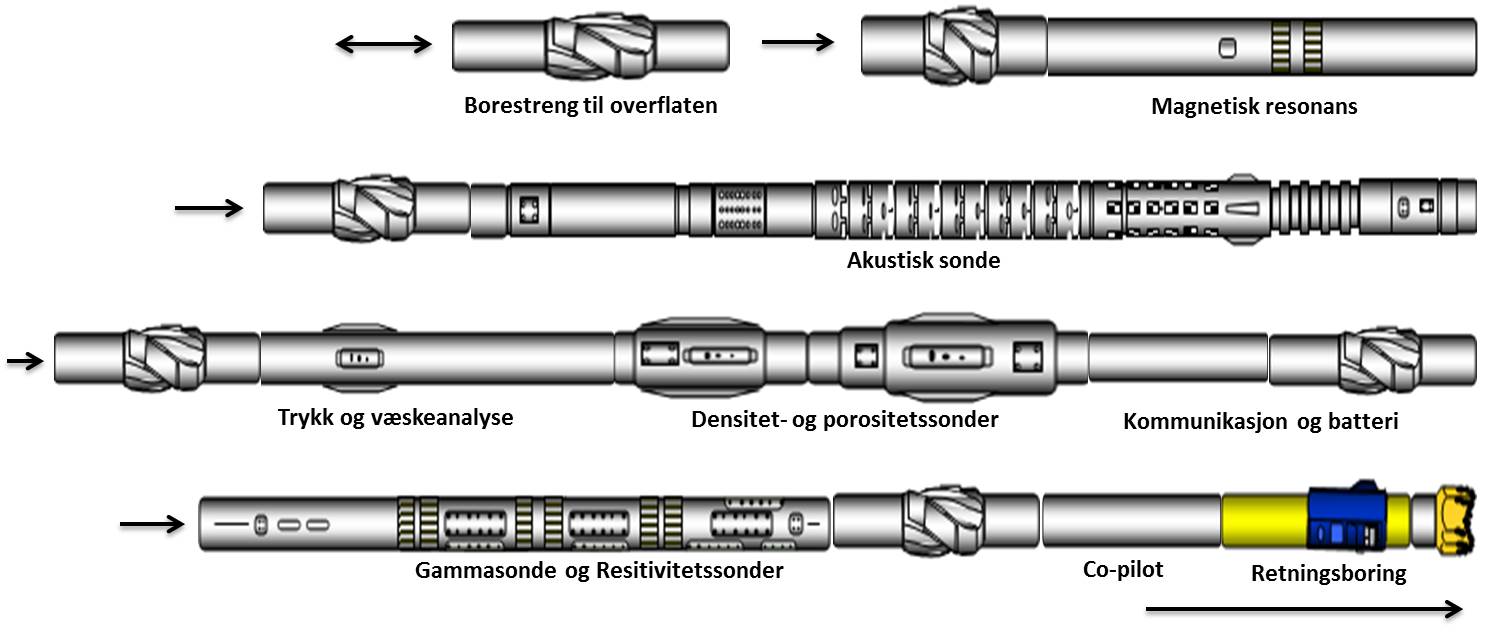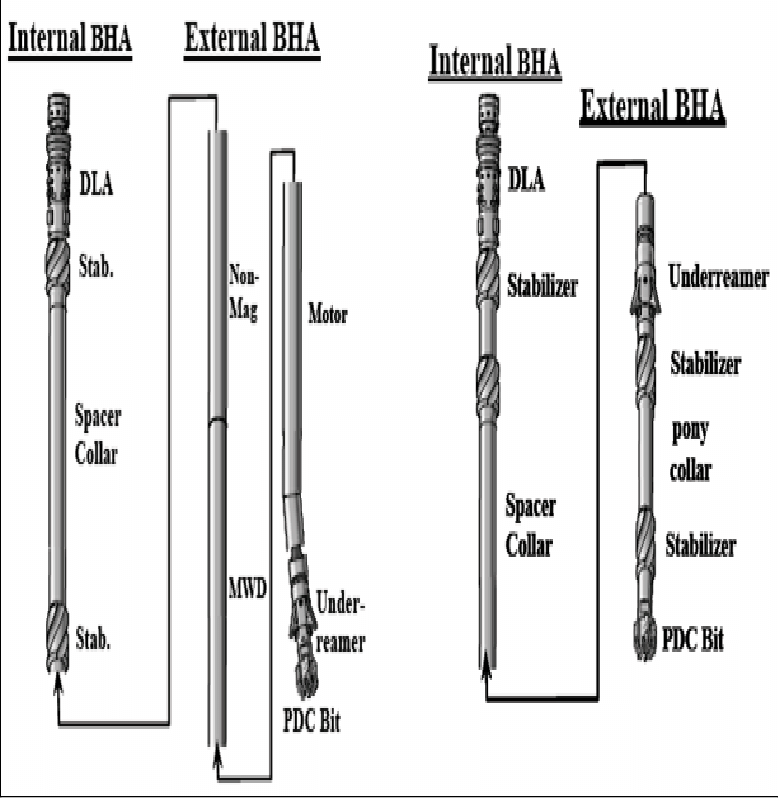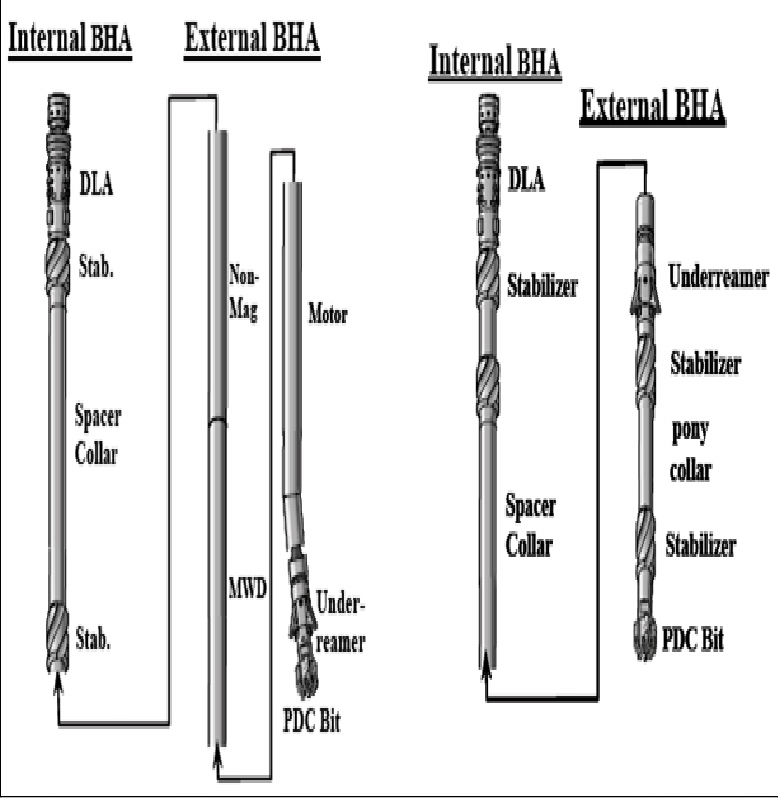Bottom Hole Assembly or BHA
Bottom Hole Assembly 101
Bottom Hole Assembly or BHA

The Bottom Hole Assembly (BHA) is a key component of the drilling system, consisting of various components and tools (including the drill bit itself) which operate at the bottom of the wellbore and physically drill the rock.
The BHA is connected to the drilling rig by the drill pipe, an extendable hollow tube which conveys the mechanical and hydraulic energy and movement from the surface rig systems to the bottom hole assembly. This complex arrangement of tools varies considerably depending on requirements, and can stack up to 1,000 ft long. The BHA has become more complex over time to suit the needs of drilling operations and to accommodate different tools that have been developed. This article will explain the desirable objectives of the BHA in both vertical and directional drilling. We will also highlight the different key components of a bottom hole assembly and their functions. The main purpose of a BHA is to effectively load and control the drill bit, but it also serves other functions that will be discussed below.
Designing the BHA
When designing the BHA, drillers must consider the operational objectives, characteristics of the rock being drilled, anticipated drilling parameters, and available tools. Operational objectives that should be considered include the angle being drilled, directional and depth targets, the expected ROP, and how to achieve designed build/drop rate. The geological characteristics that should influence the design of the BHA include the abrasiveness and competency of the rock, bed dip angles, and the pressure regime in the hole being drilled. The drilling parameters that must be anticipated to design the BHA include the applied RPM range, desired WOB, torque, and the anticipated shock or vibration pattern.
How an Optimized Bottom Hole Assembly Benefits the Driller
Since drilling cost is so dependent on time, employing drill bits and proper BHA tools is crucial for faster and less expensive drilling. Drilling time is greatly affected by both the rate of penetration (ROP) of the drill bit, and the number of times the BHA has to be retrieved from the bore hole. Every time a new bit is required, the entire drill string must be retrieved section by section to pull the bottom hole assembly to surface and change it out. This process is known as a round trip, or “trip” and requires time, money, and intervention from the drill crew which puts them at risk. If any part of the BHA is defective or fails, the drill string must also be pulled out from the borehole to replace or repair the defective component, an undesirable condition which we must try to avoid through careful selection of components.
It is crucial to review bottom hole assembly components, such as the drill bit, reamers, and stabilizers in terms of functionality and layout in order to limit possible damaging vibrations. Adjustments and additions to the BHA can lower the potential for vibration improving cost-effectiveness and reducing the risk of failure. To configure the bottom hole assembly, design optimization software is used to help in mitigating cost and eliminating ineffective drilling operations. Also, downhole tool measurements and data must be observed continuously to identify and record the behavior of the bottomhole assembly.
Components of the Bottomhole Assembly
The BHA is the business end of the drilling system that attaches to the drill string and is lowered down in to the hole. The threaded male and female ends of the drill pipe allow for more pipe and tools to be attached so that the drill string extends down to the thousands of feet required to drill an oil and gas well. Individual drill pipe segments, drill collars, and tools are all connected on the rig floor and then deployed downhole. These tools enhance the drilling operations and all serve different functions to work together to accomplish drilling objectives. The key structural components of the BHA are as follows:
. Heavy-weight drill pipe – These pieces of pipe have thicker walls compared to the outer diameter of a regular drill pipe, and are used as a tapered transition between the drill collars and drill pipe while helping to add weight and stiffness. As previously mentioned the drill pipe functions to connect the rig surface equipment with the bottom hole assembly and the drill bit, allowing us to pump fluid to the bit and to move the bottom hole assembly as needed.
. Drill collars – These are the large diameter and heavy pieces of pipe above the drill bit and below the drill pipe, which constitute the fundamental structure of the BHA. The weight of the drill collars applies compressional force (WOB) directly to the bit while keeping the more flexible drill pipe in tension to prevent buckling. This also conveys momentum and stiffness as the entire drilling assembly rotates, in order to keep the bit drilling smoothly and consistently.
. Stabilizers – These are short components with larger diameter fins called “blades” which stick out close to the diameter of the hole being drilled and are used to centralize the drilling assembly within the hole. Stabilizers have these blades attached or integrated to their external surface and are distributed from above the bit and through the drill collars depending on what form of stabilization is required. As the components with the largest diameter in the BHA they often interact with the sides of the well, creating friction and a restriction on fluid flow, so their design and positioning is crucial.
. Reamers – These are tools that enlarge, maintain or trim the side of the wellbore for various reasons, including easier electric logging, improved drilling performance and bit life, and reduced friction and vibration caused by a miss-shaped hole.
. Various Subs – These are short components that are often used to connect other pieces of the BHA (crossover subs), or carry out specific functions. Some examples of the latter are subs which redirect or control the fluid flow (diverter and float subs), and subs which absorb movement and vibration to protect the assembly (shock subs and vibration dampening tools).
In addition to the main components listed above, the BHA typically includes a downhole motor or a Rotary Steerable System (RSS), and Measurement While Drilling (MWD), and Logging While Drilling (LWD) tools. These are the main drilling, steering, and recording components that, along with the bit itself, do the work of the bottom hole assembly:
. Down Hole Motors – These motors provide additional power to the drill bit by converting the energy and flow of the drilling fluids to create additional rotation, and torque using a cavity pump system. This tool improves efficiency and power as it is connected directly to the bit. The housing of the motor also contains a fixed bend angle that can be pointed in a required direction to make the bit steer.
. RSS – This will replace conventional down hole motor directional tools to help control wellbore trajectory in directional drilling. There are many different designs of tools but they all sit directly behind the bit and either push or point it in the required direction to make it steer. A rotary steerable tool is more expensive than a down hole motor but offers more precision and control.
. MWD and LWD Tools – These tools are drill-collar-like components containing complex electronics and sensors. MWD tools measure and record the physical properties of the drilling process while LWD tools use electronics and sensors to log the properties of the rock and the drilling environment. These tools communicate this data to the drilling team on surface in real time so that they can adjust the drilling process to achieve objectives.
As mentioned earlier, the drilling parameters, and more importantly the direction of the wellbore, determine the necessary tools that make up the bottom hole assembly.
Vertical Drilling
A vertical hole is a hole that is drilled straight down in to the earth’s surface, with some minor vertical deviation allowed. There are many different layouts of BHA that are used to drill vertically, but most use little or no stabilization near the drill bit, combined with the weight of the drill collars, to allow the BHA to constantly drop back to vertical under gravity and maintain a vertical hole. A down hole motor with a straight housing is sometimes used to improve performance in vertical drilling by adding extra RPM and power directly to the bit.
Directional Drilling
Directional drilling is any type of drilling method that is intended to hit a predetermined subsurface target. These targets are precisely pre-planned so that the drilled well goes exactly where needed within the reservoir rock, often when the target reservoir cannot be accessed using a straight vertical hole from surface. This can occur if multiple wells are required from the same surface pad or platform, if the area is inaccessible for various reasons, or simply just to maximize the recovery potential by having more hole through the reservoir rock. A directional bottom hole assembly has almost an infinite number of layouts depending on what targets are required and what tools will be incorporated. Typically though, the BHA for a directional hole will incorporate either a down hole motor or a rotary steerable system in order to point, push, or steer the bit in the correct direction. The directional BHA will also contain an MWD tool which measures the angles and trajectories of the well bore and relays them back to surface to make sure the well is still on target.
Functions of the BHA
In drilling operations, the bottom hole assembly consists of components of the drilling system that act as penetrating, stabilizing, and maximizing tools to help aid in discovering hydrocarbons. The BHA provides the weight exerted on the drill bit to effectively break rock and so it also functions to provide the strength and stability needed to run in compression. The stabilizers that are in the bottom hole assembly help in preventing bit instability from the vibrations and wobbling that occur when shearing through rock formations. The BHA also helps in maximizing directional control by providing both stiffness and the precision tools necessary to steer the bit in the correct direction. Factors including hole shape, direction, and well characteristics are determined by the BHA, and so proper design of the bottom hole assembly must be made to control direction, ensure safety, and increase drilling efficiency.
Located at the end of the bottomhole assembly is the drill bit, which cuts through the rock structure to explore and exploit oil and gas reservoirs. Using a bit that is right for your drilling application is important, and having the right bottom hole assembly provides support, direction, weight, torque, and capabilities to maximize drilling performance. The bit design and the BHA layout should be carefully planned and matched in order to maximize the performance of both. Proper selection of the BHA and the drill bit help deliver drilling functionality, effectiveness, and overall results. Through examination of field results and research, our team works to constantly improve to ensure that our PDC bits and downhole tools are not the limiting factors in drilling operations.
At Ulterra, we develop groundbreaking technology to suit our customer’s drilling operations. Our patent-pending CounterForce® technology is a true advancement in PDC bit design. Unlike conventional PDC bits, CounterForce technology has a unique cutter orientation that allows the cutters to work together and force the bit to grasp the bottom hole pattern. Our CounterForce technology reins-in lateral forces and redirects them.











